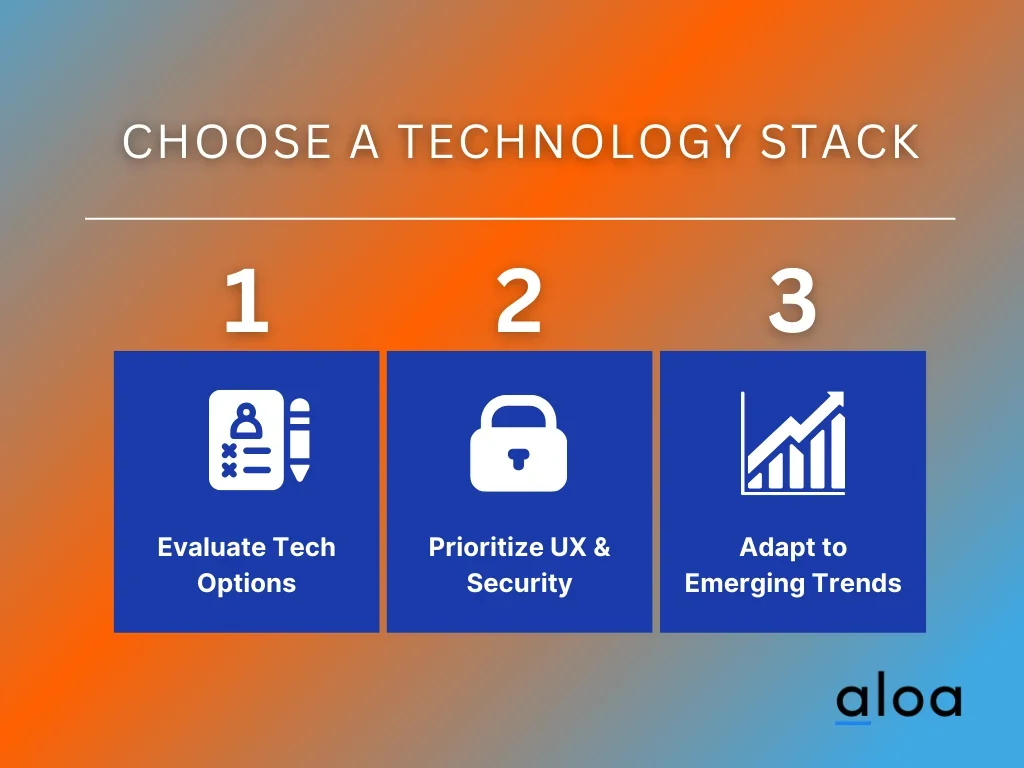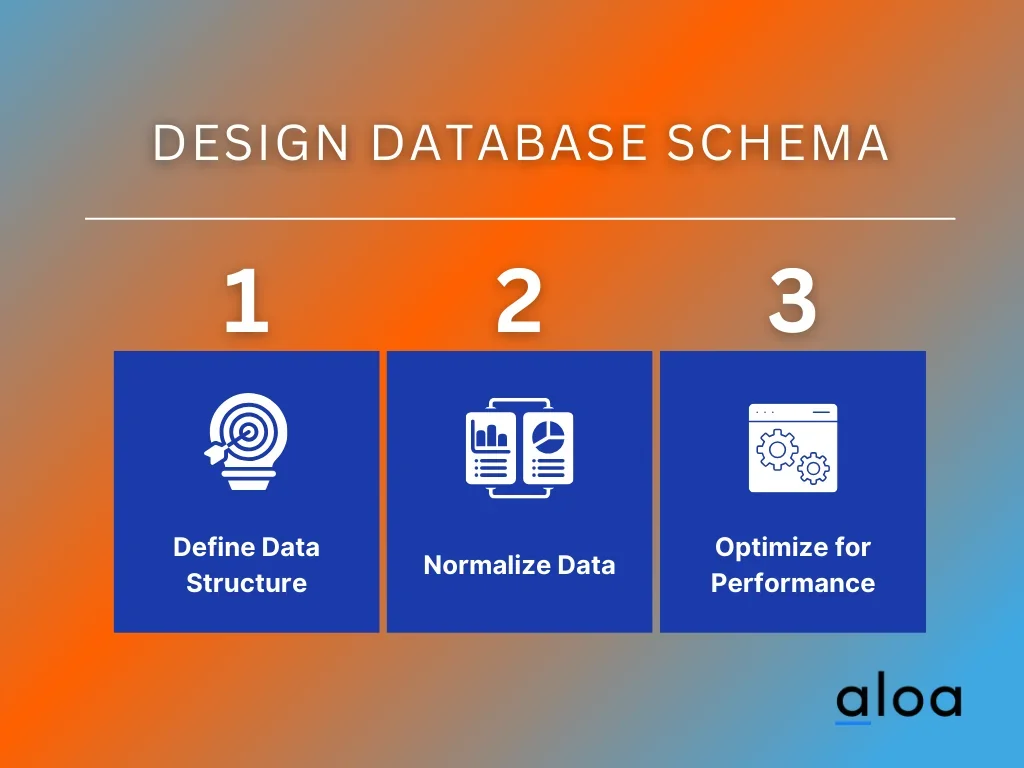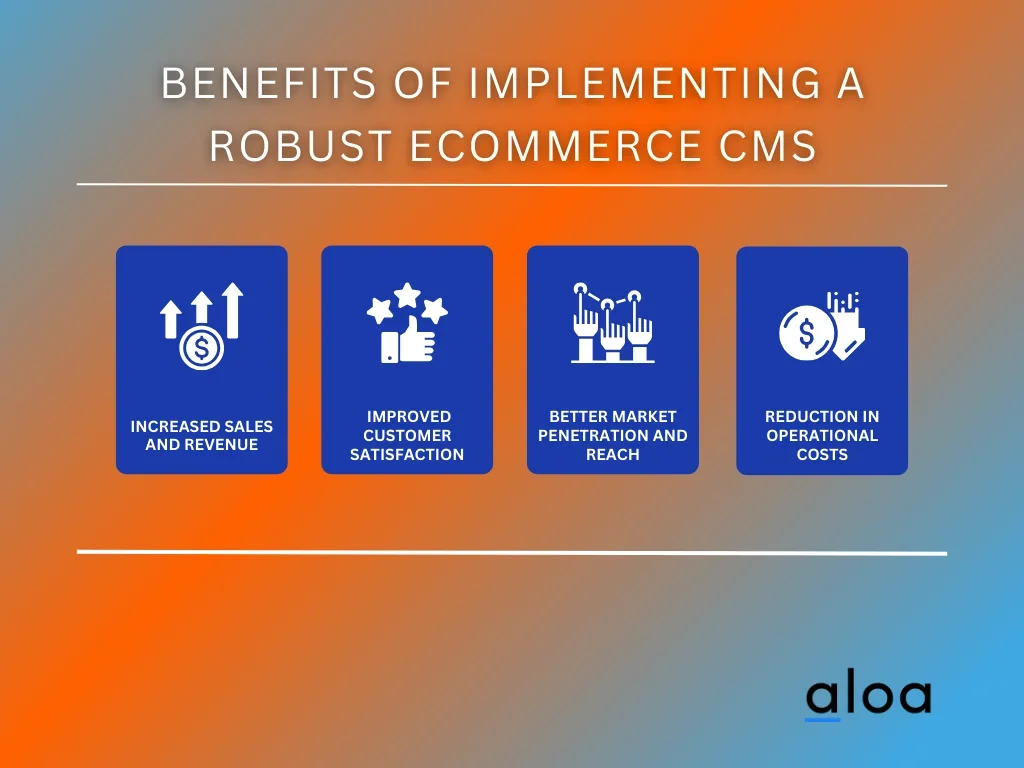The demand for online shops has drastically surged in today's digital era. As businesses flock to establish their online presence, the need for effective store management grows. Ecommerce CMS is a central hub that allows store owners to display and sell their products and services online. An effective CMS will give your business a competitive edge in the dynamic landscape of online selling in recent years.
Aloa, specializing in software outsourcing, stands out in connecting businesses and startups with the right CMS developers. With our long-standing experience in the industry, our competent team implements strict vetting processes and up-to-date ecommerce tools, ensuring efficiency and proficiency in providing the best possible results for your ecommerce projects.
In this blog, we will review the basics of ecommerce CMS, its uses, features, and benefits. Afterward, you’ll know where to start and how to make it with its essential features, ensuring a solid online visibility for your business.
Let’s get started!
What is an Ecommerce CMS?
Ecommerce Content Management System, short for Ecommerce CMS, allows businesses to create and manage online stores. It provides the tools and functionality to showcase products, handle inventory, process transactions, and manage customer data.
Building a user-friendly online store ensures customers enjoy a smooth and hassle-free shopping experience. By leveraging the capabilities of an ecommerce CMS, businesses can provide personalized product recommendations, offer promotions, and optimize customer experience, ultimately leading to increased sales and customer satisfaction.
How to Build an Ecommerce CMS (Content Management System)
Building an ecommerce CMS (Content Management System) requires careful planning and execution. Knowing the basics on how to make it will both result in your business's success and your target users' satisfaction. Below are the critical steps involved in the process.
.webp)
Step 1: Define Requirements
To build an ecommerce CMS, businesses must first define their requirements and create a solid business plan. This involves outlining the key functionalities and goals of the CMS. Small businesses and business owners should consider product management, customer management, order processing, and marketing capabilities. Defining comprehensive requirements and having a clear business plan ensures that the ecommerce CMS aligns with the business model and provides the necessary features to succeed in online marketplaces.
Below are some factors to consider when doing this step.
- Identify Key Functionalities: Clearly outline the essential functionalities needed for your e-commerce CMS, including product management, customer management, order processing, and marketing capabilities.
- Set Clear Goals: Define specific goals for your CMS, such as improving user experience, increasing sales, or expanding market reach. Align these goals with the overall business strategy.
- Consider Business Model: Tailor the CMS requirements to align with your business model, considering the unique aspects of your products, target audience, and market positioning. This ensures that the e-commerce CMS effectively supports your business objectives.
Step 2: Choose a Technology Stack
Choosing the right technology stack is crucial for building a robust ecommerce CMS solution. Businesses must evaluate technology options and select the tools and frameworks that best suit their needs. Factors to consider include mobile devices and wallets, user experience, security, scalability, and payment methods. Leveraging new technology trends, businesses can develop an ecommerce CMS with a successful digital storefront that supports online transactions, provides a seamless user experience, and adapts to emerging customer preferences.
Here are some factors to consider when following this step:

- Evaluate Technology Options: Carefully assess various technology options for building an e-commerce CMS. Consider factors such as compatibility with mobile devices, user experience, security features, and scalability. This evaluation forms the basis for choosing tools and frameworks that align with the business's requirements.
- Prioritize User Experience and Security: When selecting a technology stack, prioritize elements that enhance user experience and ensure robust security. Choose tools that facilitate seamless user navigation and implement security features to safeguard online transactions and sensitive customer information.
- Adapt to Emerging Trends: Stay informed about the latest technology trends and incorporate them into the chosen stack. By leveraging emerging technologies, businesses can develop an e-commerce CMS that supports current online transactions and adapts to evolving customer preferences.
Step 3: Design Database Schema
Designing a database schema is a critical step in building an ecommerce CMS. It involves structuring the data architecture of the CMS, including customer data, product pages, and digital products. A well-designed database schema ensures efficient data organization, retrieval, and management, resulting in a smooth user experience. It also allows businesses to implement data-driven marketing strategies and make data-backed decisions to improve sales and customer satisfaction.
Here are some key factors to consider when designing a database schema:

- Define Data Structure: Clearly outline the data elements needed, such as customer information, product details, and digital products. Determine the relationships between different data entities to understand the database structure comprehensively.
- Normalize Data: Apply normalization techniques to eliminate data redundancy and enhance efficiency. This involves breaking down data into organized tables and establishing relationships to reduce redundancy, ensuring that information is stored logically and consistently.
- Optimize for Performance: Consider performance optimization by indexing key fields, utilizing appropriate data types, and organizing data to facilitate efficient queries. This optimization ensures quick data retrieval, providing a seamless user experience within the e-commerce CMS.
Step 4: User Authentication and Authorization
User authentication and authorization are essential aspects of an ecommerce CMS. Authorizing it provides a seamless user experience, allowing customers to easily register, log in, and access their accounts. User authorization also ensures that individuals have the appropriate permissions and privileges within the ecommerce CMS, maintaining data security and compliance. Some essential guidelines when incorporating this step are as follows:
- Implement Secure Authentication: Ensure the implementation of secure user authentication methods, such as multi-factor or biometric verification. Doing so enhances the overall security of user accounts and protects sensitive information.
- Streamlined User Registration and Login: Design a user-friendly registration and login process, minimizing customer friction. Enable easy registration, password recovery, and login procedures to enhance user experience and encourage seamless access to their accounts.
- Define Granular Authorization Levels: Establish granular user authorization levels within the ecommerce CMS, assigning specific permissions and privileges based on roles. This ensures that individuals only have access to the necessary functions, maintaining data security and compliance with privacy regulations.
Step 5: Product Management
An ecommerce CMS should provide robust product management capabilities. This includes adding, organizing, and updating product listings, managing inventory, and optimizing product assortment. Effective product management ensures businesses can efficiently sell goods online, maintain accurate inventory levels, and adapt their product offerings based on market demand. By leveraging product management features, companies can streamline operations, enhance customer satisfaction, and drive sales.
Here are some factors to consider when managing products:
- Comprehensive Product Listings: Implement a feature-rich product management system allowing businesses to add, organize, and update product listings effortlessly. Ensure a user-friendly interface for easy navigation and efficient handling of a diverse range of products.
- Inventory Control: Enable robust inventory management within the ecommerce CMS, ensuring accurate tracking of stock levels. This feature aids businesses in maintaining optimal inventory, preventing overselling or stockouts, and enhancing overall operational efficiency.
- Adaptive Product Assortment: Facilitate product assortment optimization based on market demand and consumer preferences. Provide tools for businesses to analyze sales data, identify trending products, and make informed decisions about adjusting their offerings to meet evolving market requirements.
Step 6: Shopping Cart and Checkout Process
An ecommerce CMS must have a user-friendly shopping cart and checkout process. The shopping cart allows customers to add products, view their selected items, and proceed to checkout. Similarly, the checkout process should be seamless, with clear instructions, multiple payment options, and data security measures.
Businesses must optimize the shopping cart and checkout process, as they contribute to a positive user experience, reducing cart abandonment rates and increasing online sales. Here are the steps when applying the shopping cart and dealing with the checkout process:
- Optimization for User Experience: Prioritize a seamless and responsive design for the shopping cart and checkout pages. Optimize the layout for various devices to enhance accessibility, ensuring a positive and consistent user experience across platforms.
- Clear and Concise Checkout Instructions: Provide straightforward and easily understandable instructions during checkout. Communicate each step, making it intuitive for customers to follow through, reducing confusion and increasing the likelihood of completing the purchase.
- Diverse Payment Options: Offer various payment options to accommodate diverse customer preferences. Whether credit cards, digital wallets, or other methods, providing flexibility enhances convenience, caters to a broader audience, and boosts conversion rates.
Step 7: Responsive Front-end Design
In an increasingly mobile-driven world, responsive frontend design is crucial for an ecommerce CMS. Mobile commerce, or m-commerce, is rapidly growing, with more customers shopping on mobile devices. A responsive front-end design ensures the website is accessible and user-friendly across different devices, such as smartphones, tablets, and desktops, as well as through a mobile app. By optimizing the user experience, businesses can increase customer engagement, drive sales, and build customer loyalty.
Below are vital factors you can consider when creating a responsive front-end design.
- Mobile-Friendly Interface: Develop a front-end design that adapts seamlessly to various screen sizes, prioritizing a mobile-friendly interface. This ensures optimal user experience, accommodating the growing trend of mobile commerce.
- Cross-Device Accessibility: Implement responsive design principles to guarantee accessibility across diverse devices, including smartphones, tablets, and desktops. Consistent user interface and functionality contribute to a positive shopping experience, promoting customer engagement and satisfaction.
- Enhanced User Engagement: A responsive frontend design enhances user engagement by providing a consistent and user-friendly experience. By optimizing the website for different devices, businesses can capture a broader audience, drive sales, and foster customer loyalty in the competitive e-commerce landscape.
Features of an Ecommerce CMS
An e-commerce CMS offers a variety of features that enable businesses to create and manage their online stores successfully. Let's look at the key aspects from both the admin and user sides, ensuring the success of your ecommerce CMS and providing a user-friendly and secure shopping experience.

Admin Side Features of an Ecommerce CMS
An ecommerce CMS provides a range of admin side features that enable business owners and administrators to manage their online stores effectively. These features allow administrators to navigate and control the system, ensuring smooth operations, informed decision-making, and optimal security performance.
Here are the essential admin side features to consider:
- User Management: Allow administrators to create, manage, and track customer accounts. Admins can utilize this feature to handle customer inquiries, process returns, and manage customer loyalty programs, all from a centralized admin panel. As a result, businesses can gain valuable customer data, facilitate marketing strategies, and ensure a seamless customer experience.
- Product Management: Organize and manage a company’s catalog, including features like inventory control, product categorization, and product attributes. This feature utilizes various ecommerce tools, allowing businesses to list and manage products for accurate inventory levels efficiently, heightened product visibility, and maximum sales potential.
- Order Management: Simplify handling online transactions and managing customer orders. It allows businesses to efficiently process orders, track shipments, and handle customer inquiries. This enables enterprises to deliver a seamless customer experience, ensuring timely order fulfillment and customer satisfaction.
- Analytics and Reporting: Track website traffic, monitor sales data, and measure the effectiveness of marketing campaigns. These insights enable companies to make data-backed decisions, optimize marketing strategies, identify areas for improvement, drive sales, and enhance customer satisfaction.
- Promotions and Discounts: Attract new customers, retain existing customers, and boost sales. Ecommerce CMS platforms provide features for creating and managing promotional campaigns, such as discounts, coupons, and special offers. You can use various platforms to share your coupon and discount codes with your customers.
- Security and Compliance: Protect customer data, prevent fraud, and ensure compliance with data protection regulations. This includes implementing measures such as SSL certificates, encryption, secure payment gateways, and privacy policies.
User Side Features of an Ecommerce CMS
In addition to admin features, an ecommerce CMS provides various functionalities specifically crafted to elevate user experience and productivity. The user-oriented features are designed to facilitate smooth interaction and optimize engagement with the platform.
Some key user-side features include:
- User Registration and Authentication: Customers can create accounts, securely log in, and access personalized information. Its ability to securely save preferences, track orders, and store payment information facilitates a seamless shopping experience.
- Product Browsing: Enable customers to search for products easily, explore product categories, and surface the products that meet their needs. With features like search filters, sorting options, and product comparisons, this feature enhances the user experience by finding products quickly and efficiently.
- Shopping Cart: Enhances the overall shopping experience. It can easily add or remove items, view cart contents, and calculate order totals. This, in turn, reduces cart abandonment rates and eventually increases sales conversions.
- Checkout Process: Simplifies payment and order fulfillment, ensuring a smooth transition from shopping cart to completed purchase. It includes secure payment gateways, multiple shipping options, and order summary reviews.
- Order History: Enable customers to view past purchases, track orders, and manage customer accounts. Its features contribute to customer satisfaction by providing transparency and convenience, allowing customers to quickly revisit past purchases, reorder items, and monitor the status of their orders.
- Wishlist: Allows customers to save, review, and manage their bucket list of products for future reference. Its receiving notifications mechanism about price changes or availability enables informed purchasing decisions over time.
Benefits of Implementing a Robust Ecommerce CMS
Implementing a robust ecommerce CMS offers businesses numerous benefits, enabling them to thrive in the digital landscape. Let’s discover its essential vital benefits to your platform:

1. Increased Sales and Revenue
An ecommerce CMS can significantly boost sales and revenue for ecommerce business owners by expanding their online presence, attracting potential customers, and optimizing strategies. It provides businesses the tools to market products effectively, offer personalized shopping experiences, and streamline order fulfillment processes. With the best CMS options for eCommerce, companies can tap into new revenue streams, such as subscription services, adapt to changing customer preferences, and drive online growth in the rapidly expanding ecommerce industry with the help of artificial intelligence.
2. Improved Customer Satisfaction
An ecommerce CMS helps businesses deliver a superior customer experience, resulting in high customer satisfaction. With advanced features like personalized product recommendations, seamless shopping carts, and user-friendly interfaces, the best ecommerce platforms enhance the overall shopping experience. Similar platforms enable efficient customer support, allowing businesses to promptly respond to customer inquiries, address issues, and gather valuable feedback to continuously improve service quality through ease of use and ecommerce marketing personalization. By choosing one of the best ecommerce CMS platforms, businesses can ensure enhanced customer satisfaction and loyalty, making the right choice for their customers.
3. Better Market Penetration and Reach
Implementing an ecommerce CMS enables businesses to expand their market reach, tapping into new customer segments and geographical markets worldwide. Its solid impact on penetrating online presence results in enhanced visibility among online shoppers, including on popular social media platforms like TikTok, Facebook, and Instagram, thereby increasing market penetration and physical store presence. Companies can now expect to grow their customer base, generate more sales, and compete effectively in the digital marketplace.
4. Reduction in Operational Costs
Ecommerce CMS platforms automate various business processes, such as inventory management, order fulfillment, and customer support. This offers businesses significant cost savings and operational efficiency compared to traditional brick-and-mortar operations. As a result, businesses significantly lower their operating costs by eliminating the need for physical storefronts and reducing overhead expenses while enhancing operational efficiency with SaaS ecommerce stores platforms like BigCommerce and other top SaaS ecommerce platforms, including their own store. Additionally, using a SaaS CMS eliminates the need for businesses to invest in separate servers and data storage, further reducing operational costs.
Key Takeaway
Building an ecommerce CMS significantly benefits your online business. A robust CMS can streamline your operations, enhance user experience, and drive more sales and revenue. With features like user management, product management, order management, analytics, and promotions, you can efficiently manage and grow your online store.
However, launching an ecommerce CMS can be challenging for many businesses or startups, specifically when figuring out where to start or what steps to take. Thankfully, with the right team of ecommerce software developers, you won’t have to worry about these challenges. By leveraging their knowledge and expertise, you can ensure a streamlined process of building your ecommerce CMS, the ultimate ecommerce solution, in no time. Ready to build your ecommerce CMS?
Contact Aloa at [email protected] today. Our competent team will provide the best-skilled experts to set up your ecommerce CMS. Reach out to our team via the Aloa hire page to learn more about sourcing the best team to handle your ecommerce CMS development project. We’ll guide you through the process and ensure your project meets market and business needs!

